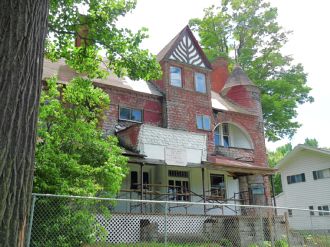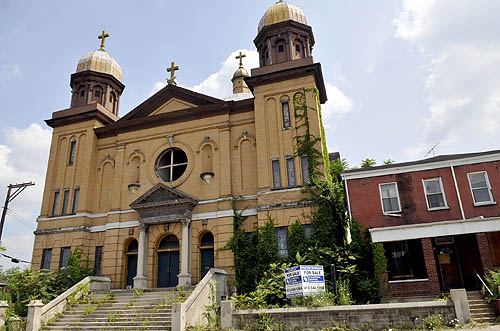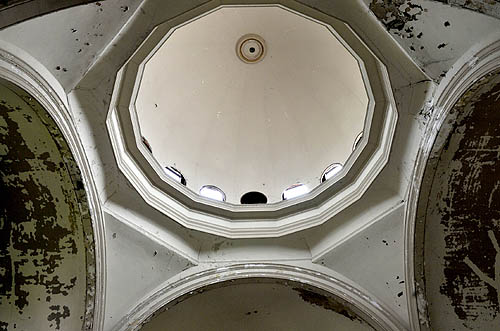
Author Archives: ryochum
-
Public Meeting for South Park Future Planning
-
Jones’ Cresson Home May Avoid Razing
Saturday, November 20, 2010By Patricia Lowry, Pittsburgh Post-GazetteThe Cresson Area Historical Association, which has owned the 14-room, Queen Anne-style house since 1990, has a tentative agreement to sell it to Andrew and Carrie Dziabo, who grew up nearby and live just a few minutes away.
The tentative agreement, reached Friday, appears to have the blessing of Cresson Township supervisors, who heard the couple outline their plans at a township meeting earlier this month.
“We’re still working on it,” said Mr. Dziabo (pronounced zay-bo). “There are issues that need to be worked out, but it’s looking promising.”
The dilapidated house has been under threat of demolition since a Cambria County judge approved its razing in late 2008. Supervisors had told the historical association the house could be torn down after Sept. 30.
A member of the historical group wrote in an e-mail that the house would be sold for a nominal fee, with the new owners also paying the township’s legal expenses incurred during the long court proceedings. Mr. Dziabo referred questions about sale price to the township solicitor, who was unavailable Friday.
Mr. Dziabo grew up a block away from the Jones cottage, in a historic house that also was part of the Mountain House resort grounds. He worked with his father, civil engineer Michael Dziabo, on restoring that house, and the two plan to collaborate on this one.
While Andrew Dziabo, who works for a power company, has admired the Jones house since he was a child, it wasn’t until the historical group offered tours in the spring that he was able to see the interior.
“The house isn’t in as bad shape as I thought,” he said. “It’s actually very sturdy inside. There is some water damage that ate the plaster in a lot of the rooms, but as far as the structure goes, it seems pretty sound and sturdy. The floors don’t even creak.”
The Dziabos intend to restore the exterior and preserve as much of the interior woodwork as they can.
“The whole appeal of it to my wife and me is the character of the Victorian-style home,” he said, adding that its ornate, well-preserved foyer and staircase “would be very easy to restore. It’s just a matter of elbow grease.”
The Dziabos expect to know soon whether the Jones cottage is theirs.
“The township wants to have this issue to bed by the next [supervisors] meeting.”
-
Unusual Touches Mark Phipps’ Winter Show
Saturday, November 20, 2010The Winter Flower Show opens Friday at Phipps Conservatory and Botanical Gardens in Oakland. Nine of the indoor gardens will be bedecked with topiary snowmen, decorated trees, hanging baskets, thousands of lights and more than 2,000 poinsettias. Newer varieties of poinsettias will be on display, including ‘Polar Bear,’ ‘Winter Blush,’ ‘Ice Punch,’ ‘Visions of Grandeur’ and ‘Tapestry.’
Also on display is the garden railroad with operating trains and miniature living scenery that includes dwarf conifers. The show, which runs through Jan. 9, was designed by the conservatory staff with help from Michele McCann.
“The show is a wonderful combination of horticulture and whimsy, with beautiful new poinsettias and common annuals used in unusual ways,” says Margie Radebaugh, Phipps’ director of horticulture and education.
Special seasonal events include:
• Visits by Santa Claus on Saturdays and Sundays through Dec. 19.
• A “Garlands & Gifts” sale on Dec. 2-3 from 10 a.m. until 7 p.m.
• Phipps stays open until 10 p.m. daily, beginning Dec. 6, with candlelit walkways and live entertainment.
Admission is $12 for adults; $11 for seniors 62 and older and students with valid ID; $9 for children ages 2 to 18; free for children under 2. Information: www.phippsconservatory.org or 412-622-6914.
-
Buying Here: Larimer
Saturday, November 20, 2010By Gretchen McKay, Pittsburgh Post-GazetteOur Lady Help of Christians in Larimer was barely 5 years old when fire ripped through it in 1905, destroying the church at the corner of Meadow and Turrett streets. The Italian immigrants who had guided its construction in 1898, though, were a resolute bunch.
Within a year they’d rebuilt the Baroque-style structure, and until it closed in 1992, Help of Christians served as a center of Italian-American religious and social life, hosting not just Catholic Masses but everything from the annual celebration in honor of St. Agnello Abate to an array of sporting activities for neighborhood kids.
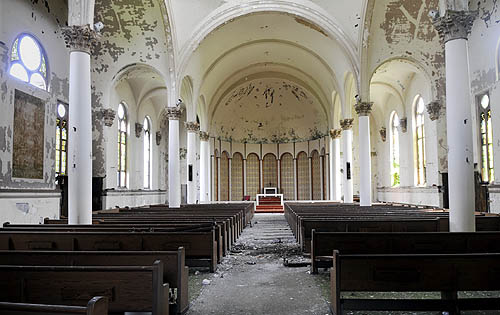
The ceiling and plaster walls have peeling paint at the former Our Lady of Help Christians church in Larimer. J. Monroe Butler II/Post-Gazette
Like many churches in the city, however, its parish aged and dwindled and was merged in the 1990s with five others to form St. Charles Lwanga parish in Lincoln-Lemington. In 1995, the Pittsburgh Catholic Diocese sold the church, which has a banquet hall in the lower level, and adjacent rectory to Heavenly Vision Ministries.
Three years ago, Heavenly Vision put 6513 Meadow St. back on the market, at first quietly through word of mouth, and then last year officially for $169,000 through Coldwell Banker Real Estate’s Fox Chapel office (www.pittsburghmoves.com; MLS No. 838378; 412-963-7655).
 Larimer
Larimer
At a glance- Website: www.city.pittsburgh.pa.us/district9/
- Size: .445 square miles
- Population: 2,602 (2000 census)
- School district: Pittsburgh Public, pghboe.net
- Enrollment: About 28,000
- Average 2010 SAT scores: (Peabody High School) 379 verbal; 410 math; 380 writing
- Taxes for a property assessed at $100,000 *: $2,870; City: $1,080 (10.8 mills); School district: $1,392 (13.92 mills); County: $398 (4.69 mills)
- Wage tax: 3 percent (1 percent to the city, 2 percent to the school district)
- Bet you didn’t know: Originally settled by Germans in the mid-1800s, Larimer was Pittsburgh’s “Little Italy” until the 1960s. It is named for railroad magnate and radical abolitionist General William Larimer, who built a manor home overlooking East Liberty along a path that would eventually become known as Larimer Avenue.
* Includes the Act 50 Homestead Exclusion, which reduces assessed market value by $15,000 for county taxes.Time has not been kind to Help of Christians, which could accommodate up to 1,000 worshippers in the nave and balcony in its heyday in the ’50s and ’60s. The amount of repairs necessary to breathe life back into the property are pretty extensive.
There is no glass in its long, arched windows and holes in the roof. The coved ceiling and plaster walls are peeling paint. Vandals have broken the pews and stolen the pipes from the organ. Carpeting is matted with dust, debris and pigeon feathers. The hand-painted frescoes that brightened the chancel are so badly faded and tarnished you almost can’t tell they were ever there. There’s no heat or water.
“People go in an ooh and aah over the architecture, but it’s a broken structure,” says Realtor Ted Harchick, who shares the “as-is” listing with Dan Boehler.
Adding insult to injury are the many thefts that have stripped the space of most everything of architectural significance. Only a handful of the dozens of original stained-glass windows remain. And it’s only because they’re too heavy to lift that looters also didn’t carry away the marble communion rails in the chancel.
Most heartbreaking is the massive circular window that crowned the front door. Somehow, the robbers managed to sneak the stained glass out of the wood framing in the stealth of night.
Vandals also have trashed the 6,000-square-foot rectory, which during Heavenly Vision Ministries’ tenure housed Family Options Foster Care, in addition to church offices. The property’s current market value is $256,400 ($172,900 for the church and $83,500 for the rectory). Taxes are in arrears on the rectory.
“It’s not for the faint of heart,” admits Mr. Harchick. “We need a risk-taker.”
On the plus side is its location in Larimer. Developments such as Bakery Square, a new “lifestyle center” in the old Nabisco plant on Penn Avenue, are helping to make one of Pittsburgh’s poorest neighborhoods attractive to national retailers and other businesses. UPMC, for instance, is planning to open a technology development center there by the end of the year, and Free People, a hip clothing boutique, follows on the heels of Anthropologie this winter. Next year, a $1.8 million, 14,500-square-foot vocational center funded by the Urban Redevelopment Authority and the Small Business Administration will open not far from the church on Meadow Street.
The Rev. Armenia Johnson, leader of Heavenly Vision Ministries, says she will be very careful in selecting a buyer for the old church.
“We want them to restore it into something that is beneficial and positive for this community,” she says.
In other words, if you’re thinking “brew house” or “night club,” it’s probably not going to fly.
Rev. Johnson, who is now associate pastor of St. James Baptist in Homewood, paid $100,000 the property in 1995. Although the Garfield native did her best to maintain the elegant building, she never had the funding she needed to properly maintain or improve it. So bit by bit, the once grand structure fell into terrible disrepair.
It’s a common fate for churches, which account for a growing number of real estate listings thanks to declining membership and consolidations. According to RealSTATS, a South Side-based real estate information company, 45 churches have changed hands in Allegheny and surrounding counties since January 2009, with sales prices ranging from $5,000 for Ambassador Baptist Church in Ross to $1.1 million for Christian Community Church in Adams.
Occasionally one will make the transition from place of worship to heavenly home. But given the high redevelopment costs, it often takes a grand idea — restaurant, performance hall, multi-unit condo development — and corporate investors to fill such a grand space. CVS, for example, bought the church in Adams. Most are purchased as-is by other religious organizations, or they languish on the market for years.
“You definitely don’t have as many players,” notes Tom Conroy of Howard Hanna Real Estate Services, who has sold so many churches for Hanna’s commercial division that he’s known as The Church Guy.
Mr. Conroy’s current listings include Harvest Baptist Church in New Kensington ($199,000; MLS No. QL102931); St. Michael Church ($250,000; MLS No. QL103962) in Munhall; and St. Mary Magdalene ($159,000; MLS No. QL103653) in Homestead.
Financing, zoning and parking all can be challenges. Many older churches were built in walkable residential areas that prohibit commercial enterprises. Former parishioners add to the difficulty. Even after religious artifacts have been removed and the building is just a building, some stay emotionally attached.
“Significant events take place there,” says Mr. Conroy. “Marriages, baptisms, funerals.”
-
City Will Return Lost Art to Public
Friday, November 19, 2010By Diana Nelson Jones, Pittsburgh Post-GazetteFive sculptures that were stored for years in a public works warehouse are being put back on pedestals four years after one artist’s persistent queries led to their discovery.
Thursday morning, a crew from Mangery & Sons hoisted Peter Calaboyias’ stainless steel sculpture “Five Factors” into place on a concrete slab behind the baseball field in Mellon Park, Shadyside.
Standing beside one of the six-sided skewed cylinders, he beamed and said seeing it in public was a thrill “after all these years.”
“Five Factors” was one of four sculptures chosen in a 1971 public art competition and placed atop the garage at the Squirrel Hill branch of the Carnegie Library. They were among the first contemporary sculptures to be displayed as public art in the city. At the time, the city required that 1 percent of the construction budget for a public building be spent on art.
Thomas Morandi, Edward Bordas and Jim Myford were the other artists whose works were chosen.
Years ago, the sculptures were removed, either for repair or to accommodate changes in use of space. Mr. Calaboyias thought his sculpture had been stolen and sold for scrap, he said.
Library officials said the works had been sent to a restoration company in the 1990s. But at some time after that, the public works department retrieved the works when the company went bankrupt and stashed them in a warehouse under the 62nd Street Bridge.
They stayed there until 2006, when Councilman William Peduto’s staff learned about the sculpture and contacted Mr. Calaboyias.
The artist, who had raced to the warehouse to make the identification, said it was both distressing and exciting to see them.
“Five Factors” was inspired by ancient Greek stelae, or cylindrical stone markers that were inscribed with words or carvings, he said.
Half of a Richard King Mellon Foundation grant of $300,000 was used to restore and relocate the sculptures. The fifth was the work of Aaronel deRoy Gruber. It was originally on the portico of the City-County Building, then on the site where the David L. Lawrence Convention Center is now. It was stored with the other four.
Morton Brown, public art manager for the city, said the five pieces were in “the most dire need” of conservatorship among the city’s collection. Three went to the McKay Lodge Conservation Lab in Ohio. Mr. Myford and Mr. Calaboyias did their own repairs; in fact, Mr. Calaboyias’ is an exact replica of the original, which “had too many dents to be pounded out to save,” he said.
The Bordas piece has to hang on a wall, said Mr. Brown. Its new location has yet to be decided.
“I’m trying to find a city-owned facility that has an architectural style” that’s the right fit for “two abstract, elongated triangles welded together and painted red. Really quite beautiful. But I haven’t found the right place yet.”
The sculpture is under 200 pounds, he said.
Mr. Myford’s work — two elongated rectangular forms angled like fingers aloft — was installed two months ago in Grandview Park in Mount Washington, just above the historic stone steps off Bailey Avenue.
Mr. Morandi’s and Ms. Gruber’s works will be installed in Mellon Park.
With the rest of the grant, Mr. Brown and the Greater Pittsburgh Arts Council’s Office of Public Art will determine which pieces should next be restored, weighing costs, deterioration, visibility and the prominence of the artist, he said.
“We have 110 pieces in the collection and we have about 21” identified as most in need, he said.
“If we can get five more done next year, then we will leverage money for the others.”
-
T & T Hardware Closing After 74 Years
Friday, November 19, 2010By Emily Gibb, Pittsburgh Post-Gazette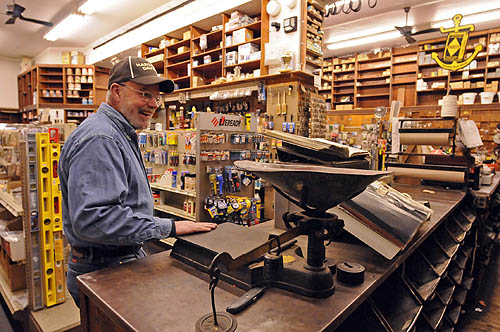
Manager Mark McNally is winding down business at T & T Hardware, a fixture at 2114 East Carson St. on the South Side since 1936. Owned by the Tumas family since its founding, the store has found it impossible to compete with big-box retailers. The scale, which has weighed countless nails and screws for sale by the pound, will remain with the Tumas family. Everything else will be marked down 50 percent Monday morning. Bob Donaldson/Post-Gazette
Pull open the solid wood door with its weathered red paint, walk into T & T Hardware Co. Inc. on the South Side and it’s a bit like stepping back in time.
Wooden shelves line the walls, some all the way to the ceiling, along with rows and rows of little wooden drawers full of screws, nuts and bolts behind a wooden counter along the back. Power tools almost seem out of place in their wood and glass displays.
But next week, after fighting off hard times the last few years, the hardware store fixture on Carson Street begins the process to shut its doors for good.
The “mom and pop” store has too much remaining inventory to liquidate or auction off yet, so beginning Monday, everything is 50 percent off the original price, said manager Mark McNally, 55, of Mount Washington.
They are waiting to see how long it takes to sell most of their inventory to set an exact closing date. This week, they’re just trying to get everything out on the shelves.
Stanley Tumas opened T & T Hardware in 1936. After he retired in the late 1980s, his son, Michael Tumas, took over ownership of the store.
It has stayed in the same spot for the last 74 years, expanding to the side and to the back as the years went on. It was a work in progress until the ’80s, Mr. McNally said.
He says they’ve always had a reputation as the place to go for “odd stuff that no one else has,” like specific plumbing parts, nuts, bolts or screws.
Since he began working at a hardware store in Mount Washington as a teenager and then managing T & T Hardware for the last 15 years, Mr. McNally has seen many changes in the business.
Part of the challenge comes from “big box” stores, like Home Depot. “They’re key why these stores are going,” he said.
Competing with a Lowe’s only five miles away has been difficult.
“It’s just too close. I can show you on my books when they opened,” he said.
Besides competing with large chains, they are competing with the economy as well.
A lot of their business used to come from commercial contractors, but if the contractors don’t have jobs to do, they won’t be coming the hardware store for supplies.
On top of the struggling economy, the South Side is a changing neighborhood.
“For a store like this, the neighborhood has to support it,” he said.
But most people in the neighborhood now rent their houses. Generally, renters aren’t in need of hardware supplies when they can just call their landlord to take care of things.
Saturday used to be the busiest day of the week for a hardware store, Mr. McNally said. Customers who had the day off work would buy their home improvement supplies in the morning. If they were having problems, they would return around noon. If they were really having problems, they would be back again around 3 p.m., Mr. McNally said.
But last year, he started closing on Saturdays — they didn’t have enough weekend business to make it worthwhile anymore.
At one time there were four or five hardware stores just on the South Side, but, he says, “times change. I understand that.”
As Mr. McNally starts a new phase, he has to say goodbye to more than a store and a building.
“The people, without a doubt — that’s what I’m going to miss the most. After 15 years you make good, good friends,” he said.
-
Woodville Plantation Offers Holiday Tours by Candlelight
Thursday, November 18, 2010Pittsburgh Post-GazetteThe Woodville Plantation living history museum will celebrate the holiday season in an 18th-century fashion with candlelight tours from noon to 8 p.m. Sunday at the historic site, 1375 Washington Pike, Collier.
Admission is $5 for adults and $3 for children ages 6-12.
The event will feature costumed guides, holiday displays and traditional decorations. Visitors will learn about holiday customs such as Twelfth Night, Boxing Day and the firing of the Christmas guns.
The full table feast celebrated during Twelfth Night will be displayed, and visitors will hear students of The Pittsburgh Music Academy perform musical selections throughout the day on a circa 1815 pianoforte.
A piece of Whiskey Rebellion history will be displayed — a flag that was once used by the whiskey rebels as a symbol of their resistance to the 1791 excise tax on whiskey.
The flag, owned by historian Claude Harkins and on loan to the Neville House Associates, is thought to be one of only two documented flags from the Whiskey Rebellion Insurrection of 1794.
Woodville Plantation, the home of John and Presley Neville, was built in 1775. It interprets life during the period of 1780-1820, the era of the New Republic. Guided tours of the house are available every Sunday from 1 to 4 p.m.
-
South Side Hardware Store Ends 74-Year Run
By Craig Smith, PITTSBURGH TRIBUNE-REVIEW
Wednesday, November 17, 2010Pittsburgh’s South Side was a different neighborhood in 1936 when Stanley J. Tumas scraped together $800 to open his T&T Hardware store on East Carson Street.
“It was an old ethnic neighborhood. People took pride in that neighborhood,” said his son, Mike Tumas, 59, of Coudersport, Potter County, who has decided to close the store his father started 74 years ago.
The hardware store became a staple of the neighborhood anchored by the nearby J&L Steel mill, he said.
“Guys would get laid off. Their wives would say, ‘You’re painting the house,’ ” Mike Tumas said. “We did well. We did a good business.”
And the business grew over the years. It doubled in size when Stanley Tumas knocked down a wall separating the building.
Father and son worked hard.
“You spent vacations, days off, working at the store,” Mike Tumas said. “That was our life.”
But T&T and other neighborhood hardware stores found it hard to compete with big box chain stores and a changing market. Modernization — fax machines and computers — proved difficult for veteran shopkeepers used to sales receipt books with 50 pages in them, Mike Tumas said.
“My dad’s idea of a fax machine was to hand you a receipt and say, ‘Run this down the corner,’ ” Mike Tumas said.
Three people will lose their jobs when T&T closes before the end of the year. Tumas said he tried to sell the business but found no takers. He plans to sell the building.
“A lot of commercial accounts told me they were leaving Pittsburgh and Allegheny County because of the taxes,” he said. “What commercial businesses are on the South Side anymore?”
Hardware stores used to dot the area — three in Mt. Washington, two in Allentown, four in the South Side.
“We ran longer than most,” said Mark McNally, T&T’s manager.
It was an uphill run.
Home Depot said its sales during the third quarter totaled $16.6 billion, a 1.4 percent increase from the third quarter of fiscal 2009. Lowe’s Cos. Inc. reported sales for the quarter increased 1.9 percent to $11.6 billion, up from $11.4 billion in the third quarter of 2009.
“It’s hard to fight the big guys — they are so big,” said Duquesne University marketing professor Audrey Guskey. “These are family owned, the money stayed here, and the owners poured their hearts and souls into the business.”
The inventory at T&T Hardware, kept in homemade wooden drawers and metal bins, will be liquidated before the store closes, Tumas said.



